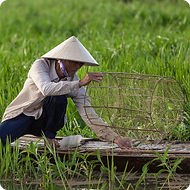.png)
THE VIET NAM MEKONG DELTA SAND BUDGET
KEY STUDY FACTS
The Viet Nam Mekong Delta Sand Budget — the world’s first delta-wide Sand Budget — is a vital initiative led by the Vietnamese government’s Ministry of Agriculture and Rural Development (MARD) and supported by WWF under the International Climate Initiative (IKI) programme and a consortium of partners led by Deltares.
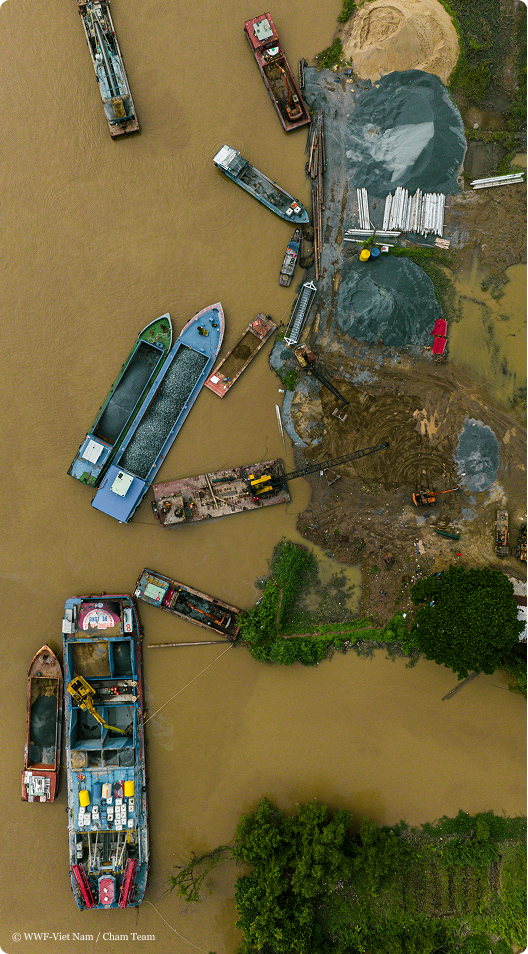
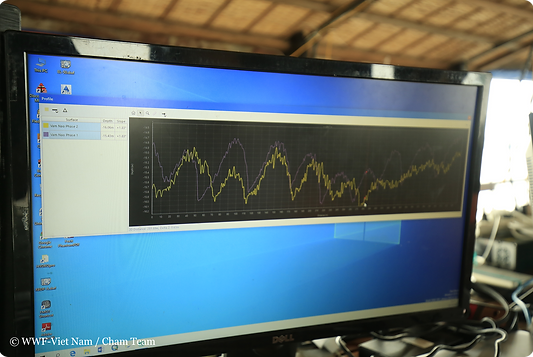
This first pilot Sand Budget was developed using data observations and analysis from 2022 with a vision to 2040. It addresses the acute environmental challenges faced by the Viet Nam Mekong Delta, which is critically vulnerable to riverbank erosion, land subsidence and saltwater intrusions that result from sediment starvation and climate change.
The main goal of the project was to develop a scientifically-grounded and evidence-based Sand Budget for the Viet Nam Mekong Delta. This initial Sand Budget will ultimately form the basis for more sustainable resource management and reducing climate vulnerability in the Viet Nam Mekong Delta — while also serving as a rubric for future Sand Budgets in other regions and ecosystems. Most importantly, a Sand Budget catalyses stakeholder engagement, which is essential for effective sediment governance and climate adaptation.
SEDIMENT DYNAMICS ARE RELEVANT TO KEY GROUPS WITHIN THE VIET NAM MEKONG DELTA FOR DIVERSE REASONS

RESIDENTS
flood, drought and loss of land; assets and livelihoods; freshwater supply risks

FARMERS
freshwater supply; soil salinisation; reduced productivity; and loss of land and assets

BUSINESSES
regulatory and reputational risks — especially for the construction sector

GOVERNMENT BODIES
public security; adaptation to climate change; water supply; food security; transport; environment; natural resources; and economic development
THE WORLD’S FIRST DELTA-WIDE SAND BUDGET
AT THE SCALE OF THE MEKONG MEGA DELTA
The project represents the first systematic and quantitative assessment of sand across the Viet Nam Mekong Delta. It addresses the critical need for managing sand, a dynamic and strategic resource, supporting the demands of economic growth and development — while preserving ecological stability.
The need for a Sand Budget stems from alarming trends:


Sand mining rates in the
Viet Nam Mekong Delta far exceed natural replenishment; sand stocks are being depleted rapidly
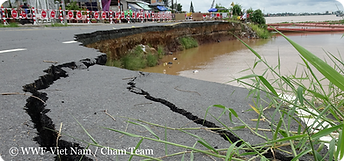

Morphological instability, riverbed deepening and coastal erosion are escalating


These dynamics are exposing millions of people to severe social and environmental disasters
By providing data on sand inflows, extractions, storages and losses, this pioneering work offers an innovative and powerful monitoring and decision-making support tool.

POLICY OUTCOMES
As provincial authorities in Viet Nam oversee the allocation of sand mining concessions, the project piloted the integration of a River Geomorphology Stability (RGS) plan and delta-wide Sand Budget in two Mekong Delta provinces’ sand management plans. The pilot assessed local conditions and evaluated how the Sand Budget and RGS plan might support improved decision-making.
WHAT NEEDS TO HAPPEN?
The project ran through 2022–2023, with fieldwork aligned to Mekong River discharge patterns.
The study’s methodology combined extensive field observations and advanced numerical modeling, structured into two main Work Packages
WORK PACKAGE 1
FIELD MEASUREMENTS
River form observation
Hydrodynamic data collection
Seismic Surveys conducted over 550 km of river systems
Multi-Beam Bathymetric Surveys (MBES) to monitor riverbed shape/bathymetry and sand movement
Suspended and bedload sediment sampling
Satellite imagery analysis

Field measurements: On-site visits and observations were first carried out, providing detailed insights into the human and natural processes that shape river forms and sand movements. These were used to frame and refine measurement methods and protocols — and to confirm which surveying equipment to use. This was followed by the deployment of various equipment and technologies to monitor sand and associated processes.
These included: river channel discharge; riverbed and suspended sediment, riverbed morphology;active sand deposit volumes and grain size; and multi-year satellite imagery.
WORK PACKAGE 2
NUMERICAL MODELING
Use a numerical model developed by Deltares to develop simulations
Model calibration and validation using field and secondary data
The model integrates various components of the sand budget study to demonstrate how sediment enters the delta and how it flows to the sea. It covers an area from 500km upstream to 80km offshore to capture fluvial-coastal interactions, including more than 8000 canals in the Mekong Delta to accurately simulate the tidal and sediment dynamics across the delta, and sand-mud dynamics to simulate sand movement.
The data sets generated in Work Package 1 were formatted and fed into a numerical model that simulated the sediment dynamics of the Viet Nam Mekong Delta under different fictitious scenarios, representative of all potential combinations of changes in parameters. The model considered variations on sediment and water distribution, sediment input to the delta and sediment trapping — and how they impact on one another and may trigger retroactive loops.

CONSULTATIONS & SECONDARY DATA
In addition to Work Package 1 and Work Package 2, a series of national and provincial stakeholder consultations — as well as analyses of secondary data on sand extraction, sand stock, and upstream (Cambodia) sand input — were also used to develop the Sand Budget for Viet Nam Mekong Delta final report.
View the Viet Nam Mekong Delta Sand Budget reports in more detail:
Figure 1 provides an overview of how the various activities and data sources contributed to the determination of the delta-wide Sand Budget.
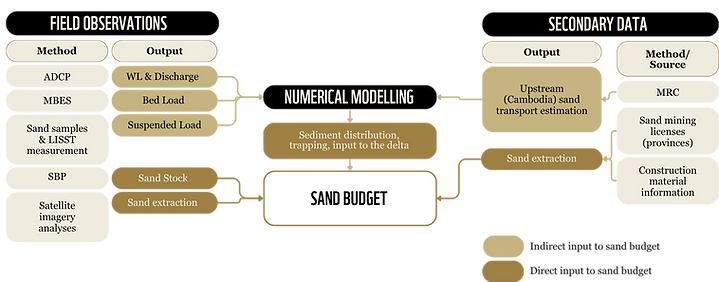
Figure 1: Overview of how project components contribute to the Viet Nam Mekong Delta Sand Budget (Deltares et al., 2023).
FINDINGS
The Viet Nam Mekong Delta Sand Budget study — covering almost a decade-long trajectory of sand extraction observations — shows that sand mining in the order of 35-55 million m3 /yr is a key driver of riverbed incision and morphological instability in the Viet Nam Mekong Delta. The total sand flux entering the Mekong Delta (2-4 million m3 /yr) is far less than current sand extraction rates.
Despite only limited volumes of sand leaving the delta through natural processes (0-0.6 million m3/yr), with foreseen sand demand in the coming decades, the existing mobile sand stock (367-550 million m3) cannot last longer than a decade (see Figure 3).
THE TOTAL SAND FLUX ENTERING THE MEKONG DELTA IS FAR LESS THAN CURRENT SAND EXTRACTION RATES.

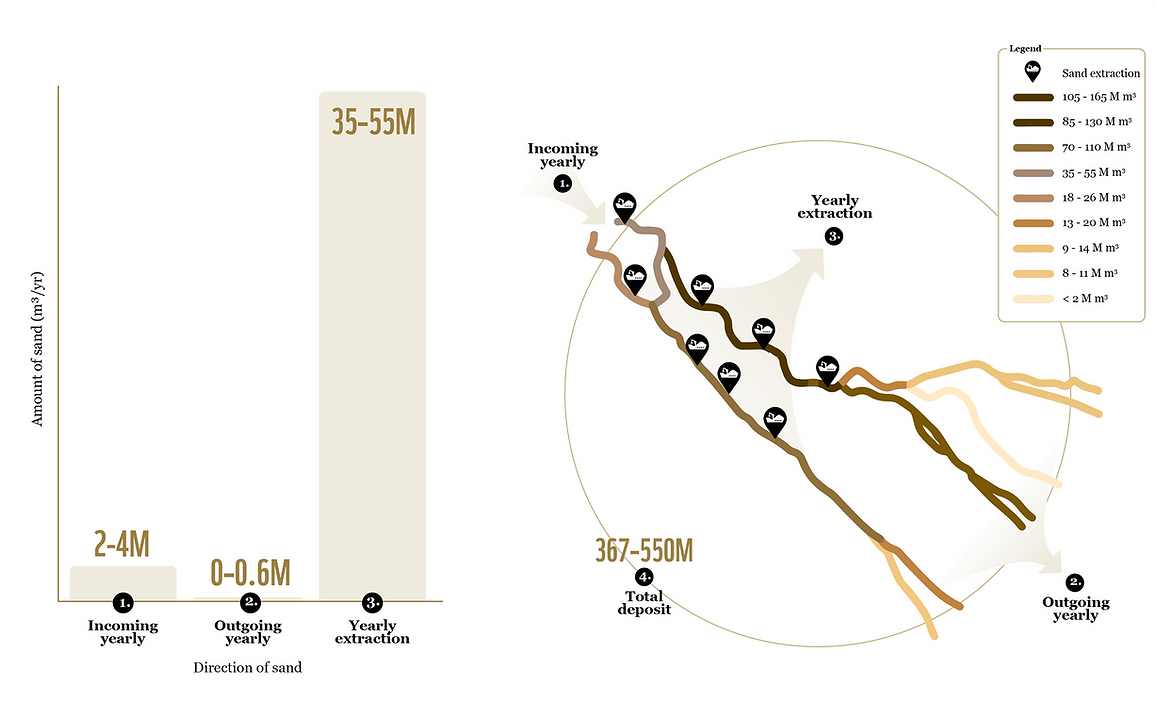
VIET NAM MEKONG DELTA SAND BUDGET
Figure 2: Overview of sand flux, stock, departure and extraction from the Viet Nam Mekong Delta with projections to 2040.
WITHOUT ACTION, SEDIMENT LOSS MAY CAUSE A 10% INCREASE IN SALTWATER INTRUSION AREAS AND SEVERELY EXACERBATE RIVERBANK AND COASTAL EROSION (Deltares, 2023).

THE VIET NAM MEKONG DELTA SAND BUDGET:
IMPLICATIONS
SAND STOCK PERSPECTIVE

Figure 3: Sand Budget of the Viet Nam Mekong Delta with a perspective of sand availability towards 2040 (Deltares et al., 2023).
The results of this study have significant implications for managing the sand resources of the Viet Nam Mekong Delta. Figure 3 shows the upper and lower estimates of the sand stock decline under three different scenarios of extraction:
FUTURE SCENARIOS
5% annual increase in extraction — exhaustion before 2035
Business-as-usual — exhaustion around 2030
5% annual reduction in extraction — stock may last until ~2040

© WWF-Viet Nam / Cham Team

In the future, the sand supply could decline because of further extraction in countries upstream and lead to further erosion through increased energy in the river flow. Therefore, future Sand Budgets should also account for the transboundary dimension of sediment replenishment.
Developing Sand Budgets can serve as an important basis for a sustainable governance of natural resources for the Mekong and other global riverine systems, reducing their vulnerability to climate change and anthropogenic stressors and protecting biodiversity.
Interested in developing a sand budget for your river system?

WWF® and ©1986 Panda Symbol are owned by WWF. All rights reserved.
_WW1269115%202.png)


